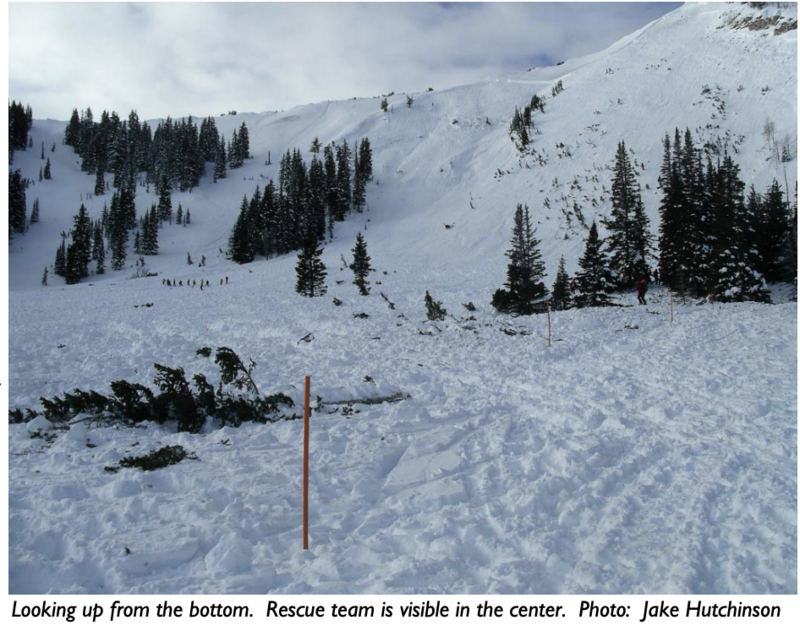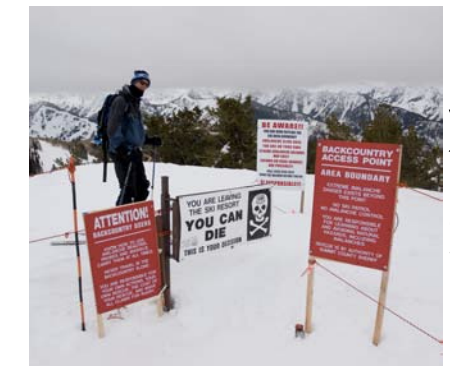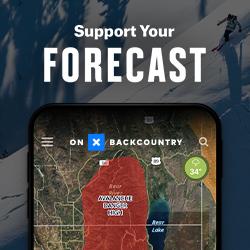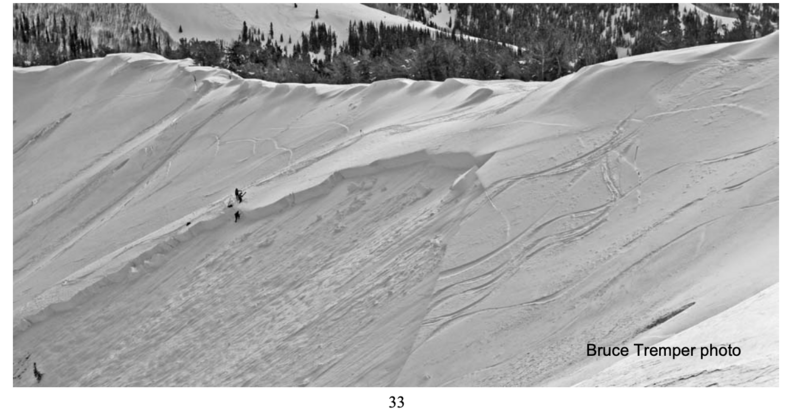Observer Name
Bruce Tremper
Observation Date
Friday, January 14, 2005
Avalanche Date
Friday, January 14, 2005
Region
Salt Lake » Park City Ridgeline » Dutch Draw
Location Name or Route
Dutch's Draw
Elevation
9,800'
Aspect
Northeast
Slope Angle
36°
Trigger
Snowboarder
Trigger: additional info
Unintentionally Triggered
Avalanche Type
Hard Slab
Avalanche Problem
Persistent Weak Layer
Weak Layer
Facets
Depth
6'
Width
400'
Vertical
1,000'
Caught
1
Carried
1
Buried - Fully
1
Killed
1
Accident and Rescue Summary
Accident Summary:
A group of five out-of-state snowboarders went to the Canyons Resort for the day and they rode to the top of the Peak 9990. They saw the nearby slopes of Dutch Draw with several dozen ski and snowboard tracks in it and noticed several other parties hiking into the area. Although most of the party members had beacons and shovels in their cars, they did not bring them that day because they did not plan to go into the backcountry. Two of the party members had taken a level I avalanche class. The party knew about the avalanche danger because they discussed it at length the previous night. They decided to go into the backcountry that day because it looked like a number of other people were doing it without incident.
They hiked the 200 yards to the top of Peak 9990 and left from the backcountry access gate, which is clearly marked with several signs warning of the danger. To leave the boundary, one must push open a gate with a large, white sign attached showing a skull and crossbones marked in large letters “You May Die”. It is legal to access the backcountry, which National Forest, but the Canyons Resorts wants to make sure everyone knows that there is no avalanche control beyond their rope lines. They hiked south along the ridge about a half mile to the top of Dutch Draw. On the way, they passed one avalanche path that had dozens of tracks in it and they went to the next path locally known as “Conehead” because of its shape from a distance. They hiked to the high point, which had only a few tracks in it and decided that it was too dangerous and they backtracked to an area where the slope angle is gentler and they could utilize an island of thick conifer trees to safely get down into the upper third of the slope.
They descended through the island of trees and they planned to enter the slope from the side by passing beneath a vertical cliff band. One snowboarderentered the slope below the cliff and Shane Maixner, 27, decided to jump off the lower portion of the cliff onto the slope—a drop of about 20 feet. He appeared to trigger the avalanche when he landed and he was engulfed in the slide. The first snowboarder managed to escape off the nearby flank of the avalanche.
Rescue Summary:
The group of snowboarders descended the avalanche bed surface and began probing with tree branches for their friend. They also called 911 on their cell phone and ski patrol from the Canyons Resort responded within about 20 minutes. After rescuers determined that the party did not have beacons and that they did not get any beacon signals from the rest of the debris, they decided that conditions were too dangerous to put a larger group of rescuers onto the slope. They escorted the remaining four snowboarders out of the area and Wasatch Powderbird Guides dropped explosives onto the upper part of the avalanche path. They triggered the next slope to the north with another large, hard slab avalanche, which was not quite as large as the original slide, but they did not trigger any hangfire above the original avalanche.
The Summit County Sheriff took over the rescue and brought in a larger team from the Summit County Search and Rescue along with personnel from Wasatch Backcountry Rescue. They used avalanche rescue dogs and probes. They finally found the body of Shane Maixner two days after the accident, buried four feet deep in a grove of trees on the extreme north edge of the avalanche path.
It proved very difficult to know how many people were caught in the slide because of widely conflicting witness accounts. The original party of snowboarders reported that they believed that they were alone in the bowl. They did not notice any one else. Three other parties, however, reported other people in the bowl. First, a party at the top of the slope was video taping the scenery from the ridge when they heard the roar of the avalanche. When they looked over the edge and continued to video the slide. The tape, reportedly, was of poor quality and inconclusive about other parties in the bowl. Second, two snowboarders were building jumps on the flats below just to the north of the avalanche runout and they were adamant that they saw others on the slope and were able to give descriptions of clothing and exact locations. Third, a party hiking up to the backcountry access point from the top of the 9990 lift claimed to see a lone skier going across the flats at the bottom, who was overcome by the slide.
Since many of the people who ski at the Canyons Resort are on vacation, it was very difficult to know who was missing at the end of the day. In fact, it took until January 17th—three days after the accident, to whittle the list down. The Summit County Sheriff announced that there was likely only one fatality and he called off the search.
Media interest was intense because the some witnesses to the avalanche initially indicated that there may have been 15 people buried. On the heels of the large mudslides in California, the national media arrived in droves and it became headline news across the country and the lead story in many of the television news programs for the next several days.
Comments
Comments
Media Reports:
This accident captured the national media attention and numerous articles appeared in many of the nations newspapers as well as being headline news on most of the national television stations. There are far too many article to include here, but this is a sample of an article as the search came to a close.
Article Last Updated: 1/18/2005 12:18 AM
Sheriff: Only 1 slide death
Search for more avalanche victims is called off
By Lisa Rosetta
The Salt Lake Tribune
Salt Lake Tribune
PARK CITY - An exhausting four-day search for victims of a massive avalanche near The Canyons ski resort is over. Summit County Sheriff Dave Edmunds said Shane Maixner, 27, who was found Sunday beneath 4 feet of snow, is probably the only person who perished.
Investigators have whittled a list of overdue or missing people to three, but Edmunds said he is doubtful they were caught in the avalanche, which Maixner is believed to have triggered.
Searchers began scouring the steep slope just after 1 p.m. Friday without knowing how many people they were looking for, although they believed as many as five were caught in the avalanche, according to eyewitness accounts.
As of Monday, however, there was no compelling evidence to suggest there were more victims, the sheriff said.
Witness accounts of what happened may have been "clouded" by the fear they experienced as they watched the disaster unfold, he said.
"They all saw something different, and this is not atypical of a situation like this."
Edmunds said the search "could ramp back up if we get further information."
Maixner's death brought Utah's 2004-05 avalanche season fatality total to seven, the most since 1950, when officials began tracking avalanche deaths.
While searchers uncovered pieces of clothing not belonging to Maixner, they believe the scattered, miscellaneous items may have been left there over time, by other skiers.
The number of searchers probing the 30-foot deep avalanche Monday was about a third the size of the crew that assembled Saturday. They navigated through bulky, debris-littered terrain in dangerous avalanche conditions, and by late Monday were fatigued, Edmunds said.
At the top of the Ninety Nine 90 Express ski lift Monday, which opened to the public for the first time since the avalanche occurred, skiers and snowboarders gawked at the devastation from behind a temporarily erected rope boundary. Ski patrol members explained to the curious onlookers that their presence on the mountain could trigger additional slides, putting the searchers' lives in peril.
By dusk Monday, only a few Red Cross workers lingered at the command center at St. Mary's Catholic Church in Park City to stack up chairs and break down tables
"This has been a huge ordeal," Edmunds said. "There have been a lot of people who have helped us through this."
The tab for the search, which is in the tens of thousands of dollars, will be jointly paid for by Summit County and the state, the sheriff said.
An accident report issued Monday by the U.S. Forest Service Utah Avalanche Center says there was some initial agreement that a snowboarder "launched over a cliff, triggering the massive slide that engulfed him and an unknown number of others that were either on the same slope or in the runout below."
Though the report does not mention Maixner by name, it says the snowboarder's body was recovered Sunday.
Rescue dogs alerted searchers to the Sandpoint, Idaho, man's body, which was found with goggles, a snowboard and a helmet.
The "hard-slab avalanche" broke up to 6 to 8 feet deep and 700 feet wide, the report states, and was composed of hard and dense new snow, wind-deposited new snow and a weak layer of snow formed during November's dry spell.
Edmunds said skiing out of bounds at ski resorts, which is what Maixner did, is a class B misdemeanor in Summit County. About a dozen people are arrested every year for the violation.
He would not speculate on whether Maixner would have been arrested had he survived the run and been observed by deputies.
"One of the things we like to do, and continue to do," Edmunds said, "is reiterate how dangerous the backcountry is."
[email protected]
---
Tribune reporter Justin Hill contributed to this story.
Where to call in a report
Summit County Sheriff Dave Edmunds urged out-of-town visitors to Park City to contact relatives in their hometowns to inform them they were not part of Friday's slide. To report someone who might be missing in the avalanche, or if you witnessed the slide, call the Summit County Emergency Operations Center at 800-828-8477.
Comments
The Dutch Draw accident thrust Utah into the national and international news as initial reports claimed that as many as fifteen people were buried in a massive avalanche adjacent to the Canyons Ski Resort. Three days later, rescuers found one victim and the following day announced that they believed that the avalanche had claimed only one victim. The media circus quickly lost interest and left town. In the mean time, the UAC staff fielded countless live television interviews, telephone calls and press conferences to a hungry crowd of national and international media. The Summit County Sheriff had the unenviable job of sorting through several conflicting witness reports and account for any missing people out of the several thousand of tourists at the Canyons Resort that day.
The only thing that was known was that a group of five out-of-state snowboarders descended into Dutch Draw using small, treed, spur ridge and Shane Maxiner, 27, from northern Idaho, jumped a small cliff onto the slope and triggered a massive avalanche 6-8 feet deep and two football fields wide, and was then swallowed up in the avalanche. Another snowboarder in their group was descending below him at the time and was able to get out to the left side and escape. The rest of the group watched helplessly from the safety of the spur ridge. Three other parties in the area reported seeing many other people on the slope at the time, but in the end, those reports turned out to be wrong. Miraculously, the avalanche claimed only one victim.
Everyone assumed that a group of five young, out-of-state snowboarders without beacons represented the typical avalanche victim—young males with little avalanche education who did not consult the avalanche advisory before they went into the backcountry. But it turned out that nearly everyone in the group had quite a bit of avalanche training and experience and they were well aware of the avalanche danger. In fact, Shane Maxiner worked as a backcountry guide in northern Idaho and the group had spent the previous evening discussing the high avalanche danger. But they had just planned to stay in bounds that day, so even though most had beacons and shovels in their cars, they didn’t wear them. They arrived at the top of the 9990 lift and saw, for the first time, the inviting powder of the adjacent backcountry and there seemed to be no lack of people enjoying it. The slope had several dozen tracks on it. So they decided that since so many other people were descending it without incident, they would give it a try.
Widespread, deep-slab instabilities existed at the time—conditions all too common to the Intermountain West. Since the huge storm the previous week had buried the weak layer under six feet of dense, hard snow, the avalanches were difficult to trigger, but if you did trigger one of these deep, monster slides, it would be almost impossible to survive. On the morning of the accident, our avalanche advisory read, “It’s like playing with an armed nuclear bomb. You can probably keep it from exploding but do you want to take the chance.” Maxiner triggered the avalanche by jumping off a small cliff on to a mid-slope snowpack where the slab was thinner and the weak layer was unusually fragile Not surprisingly, the incident rekindled the ongoing debate among the community, media, Forest Service, and the ski resorts over boundary policy of access of backcountry public land from lift-served terrain.


Coordinates




